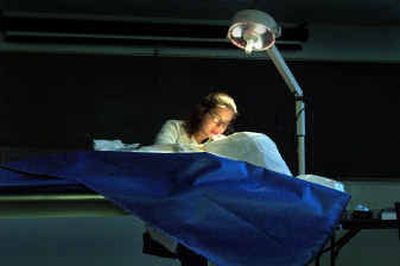Cadavers build knowledge at WSU

PULLMAN – Nothing moves in the cool open basement labs of Washington State University’s Morrill Hall. Still, the rooms are far from empty.
The blue bags on steel tables angled around the labs hold some of the university’s ultimate donors, those who leave their bodies to the school so students hoping to become doctors, nurses, nutritionists and physical therapists can learn from them. Willed-body programs across the country are losing donations because of recent scandals at other schools, including Tulane University and UCLA. Officials there and at other medical training programs have been accused or criminally charged with selling cadavers and body parts for use in private industry or experiments. At Tulane, some donated bodies were sold to a broker. According to national news reports, that broker was accused of selling cadavers to the U.S. Army, which used them for field mine testing. Now the school and the broker face a class-action lawsuit from donors’ family members. And at UCLA in March, the program director was criminally charged with selling stolen body parts through an intermediary for private companies to use in research. The school’s donation program was suspended by court order in April. But WSU remains untouched by the trouble, say local program leaders. Maybe it’s because donors know their bodies are going to a small program and are being used locally, but since the news about UCLA broke this spring, only one person has called to rescind her donation, said Dave Conley, WSU’s anatomy program director. On a morning last week, a recent WSU graduate sat quietly at the back of the lab gingerly dissecting the face of a cadaver. Music played on a radio in the background. Emily Squyer, who studied anatomy in the WSU labs last year, is helping prepare the newer donations for classes scheduled to start at the end of summer. As the new students arrive, Squyer will be headed to medical school at Pennsylvania State University. Squyer said her anatomy training at WSU and her experience this summer working on cadavers will give her a head start in her first-year medical classes. “Ultimately, I want to do trauma surgery,” she said. “I’m really fascinated with anatomy, and I also like the challenge of blending skills and instinct.” What she is learning now from the cadaver will help her treat future patients. “It’s a very huge gift somebody gave,” she said. “I’ve worked with a couple of different texts at the same time as studying a real body, none of them are as accurate as the body.” Most of WSU’s donors plan long before their deaths to leave their bodies to the university to train the next generation of medical experts and perhaps help to save future patients’ lives. They make the first contact, said Conley. “I don’t know where they hear about it, but they find us,” he said. He sends them a packet explaining the program and the necessary forms to make the donation. “It’s not a binding agreement at all,” he said. “And we can’t accept every donation.” Donors who died of an infectious disease, who died a violent death or who are obese cannot be accepted, he said. Other donations may be turned down if the body is too far out of the area to be retrieved in a timely manner, said Conley. Within 24 hours of death, the cadavers enter the program and are picked up by Kramer Funeral Home in Palouse. The bodies are embalmed to the requirements of the medical training program and then delivered to Pullman. “Within a week, the body gets to campus,” said Conley. It stays in the program for up to three years. There are currently about 40 cadavers in use at WSU. A few go to Eastern Washington University for the physical therapy training program or to the University of Idaho, but all bodies are kept whole and all are used to train students, said Conley. Those that stay in Pullman go to undergraduate anatomy classes and a few become part of the Washington, Wyoming, Alaska, Montana and Idaho medical school program, which provides the first two years of medical school for rural students. In teams of four, the WWAMI students are assigned a single body for their focused training in Pullman. No matter where they’re used, the cadavers come back to Pullman before being cremated and returned to the family for burial. If the family or the donor wishes, the ashes can be buried for free at the Evergreen-Washelli cemetery in Seattle, where WSU has a plot. After spending many long hours with a donated body, the medical students develop attachments. “Almost all of them do,” said Conley. And, though they don’t know anything about the lives of the donors – not even their names – the students hold a memorial service at the end of the year. Some read poems, some say what the donation meant to them. It can be a very touching ceremony, said Conley. “I don’t know that the donors realize how many people their donation does touch,” said Conley. “Each person can train up to 500 students.” He’s careful to remind the students of the significance of the gift. “I tell them that this is more valuable than a scholarship,” he said. “These donors are saying, ‘Here is my body, learn from me.’ ”